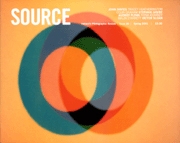Performance and Photography
'Leaving Cheyenne' by Michael Timpson was at Limerick City Gallery of Art, November 2000 - February 2001
Review by Dougal McKenzie
Issue 26 Spring 2001
View Contents ▸
Perhaps the first 'set up' occurred when Yves Klein performed The Painter of Space Hurls Himsetf into the Void in Paris in 1960. Throwing himself from a high wall, he then had the tarpaulin bearers removed from the recorded image and presented the altered photograph as a truthful statement.
Michael Timpson's photographic records of his performance works of the last 20 years are also 'set-ups', but only in the sense that they are carefully arranged and directed. No trap, trick or image altering is applied to his large format cibachromes which depict moments from a number of performances / installations from as far afield as the United States, Poland, and Turkey. Image: 'Who Blows Death's Feather' 1996, performance / installation, courtesy Ana Von Gossein, Ireland, Stefan Stux, New York
Image: 'Who Blows Death's Feather' 1996, performance / installation, courtesy Ana Von Gossein, Ireland, Stefan Stux, New York
A major part of the exhibition was a new performance / installation work, Leaving Cheyenne. In common with Timpson's previous work, the installation was meticulously arranged. Certain motifs within this work were evident in the other exhibited images from his previous performances: black, red and white cloth, naked light bulbs, metal buckets, white nightshirts. In some of these photographs Timpson himself is to be seen, wearing a dark suit. Loaves, lavatories, hay bales, motorcars and bicycles, amongst other things, are also used within the set-ups in a neatly balanced arrangement.
Timpson has a stated intention to leave the symbolism and personal meanings in his performances open to interpretation. It seemed to me that Timpson was dealing with personal displacement (he left Ireland for the United States in 1973) and a wider, recent history of the European diaspora. Hence, the boat, the bicycles and the motorcars suggest departure more than arrival. The placement of the cloth (in one image draped over lavatory cisterns) produces something akin to small religious altars. The 'breaking of the bread' is suggested in the use of the loaves. In many of the photographs, and in Leaving Cheyenne, the performers are blindfolded or have their eyes hidden or closed. This gives the work a heightened dream-like quality, within which Timpson explores personal memories of lives and events passed.
However, the main interest for me lay not so much with deciphering the symbolism of Timpson's work, but the actual format of the photographs themselves. Whilst the experience of a 'live event' cannot normally compare with a still image of it, in this exhibition the images were as potent as the performance.
Enter Charles Mayer, Timpson's photographer of the past 20 years. In the beginning, Mayer's role was simply to document the performances in order to provide Timpson with a personal archive. As the images accumulated over time, Timpson began to consider the photographs as works in themselves. The idea of exhibiting photographs of performances as works in themselves was the most interesting and problematic aspect of the exhibition.
Many photographic records of performance works are no more than useful documentation of what is traditionally a time-based and ephemeral practice. More recently, however, the 'captured image' from a live work has become an important and defining element in the work of such artists as Vanessa Beecroft and Matthew Barney.
Similarly, Timpson's images are more than just 'records'. They are around three feet by five feet, presented behind thick perspex, and most are editioned and signed. My initial suspicion was that the installations had been wholly devised for the sake of the photographs alone. Although this is in fact not the case, the highly organised nature of the installations seem to provide the photographer with any number of different options for the final, defining image of each performance. This is testimony to Timpson's skillful arrangement of objects and his choreography of the performers. However, it does also raise the question of Mayer's importance in the production of the photographs. The large-scale images in the exhibition must surely be read as a straightforward collaboration.
Back in 1960, Yves Klein employed Harry Shunk and John Kender to process his wall-jump. It should also be read as a collaborative work, right down to the tarpaulin bearers. If we are truly to read Timpson's photographs as being equal in artistic importance to the performances themselves, then Charles Mayer's role in capturing the images is a significant one.
Other articles mentioning Vanessa Beecroft:
Other articles on photography from the 'Performance' category ▸






